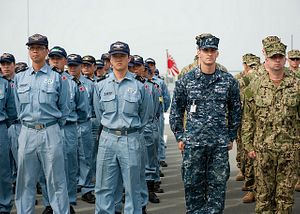It now looks inevitable that in the next few years Japan will be lifting its ban on collective self-defense. Some believe that this would be good for the United States, because it would allow Japan to “pick up the slack” in the U.S.-Japan security alliance (formally, the Treaty of Mutual Cooperation between the United States and Japan). There is a perception – largely among libertarians – that the U.S.-Japan alliance is unfair, and that the Japanese government is freeloading off the U.S.-Japan Security Treaty. Because American troops can engage in combat, and Japanese troops can’t, U.S. commentators contend that the treaty is inherently one-sided. But this is far from the truth. In fact, the U.S.-Japan security alliance has real significance for the role of the U.S. military in East Asia.
For one thing, the treaty allows the U.S. military to station its troops and dock its ships in Japan, making up the cornerstone of U.S. defense strategy in East Asia. Japan provides space and facilities for more than 50,000 U.S. military and civilian personnel, and pays the U.S. about $2 billion per year to offset the costs. These bases enable U.S. forces to be active in the Asia-Pacific, and can act as a launching point for places as far away as the Persian Gulf. The U.S. military presence in Japan is larger than is needed to defend Japan; it enables the U.S. to defend other U.S. allies in the Asia-Pacific.
U.S. troops in Japan act as a stabilizing factor in Asia, which in turn benefits the U.S. economy. American economic engagement with the region is critical for U.S. economic growth. The Asia-Pacific is the world’s most vibrant economic region, accounting for roughly half of the world’s gross domestic product (GDP). According to an April 2013 report by the Asia-Pacific Economic Cooperation forum, the region boasted the world’s highest GDP growth rate between 2010 and 2012.
There are also inherent benefits in having U.S. and Japanese troops stationed in close proximity. Communication and integration between the countries’ militaries have become more integrated, allowing for cooperative progress in important areas, such as ballistic missile defense and cybersecurity. The two countries demonstrated the strength of this cooperation during the 2013 Typhoon Haiyan rescue operation in the Philippines. The unprecedented landing of tilt-rotor aircraft on Japanese ships during the operation demonstrated the power of the alliance, and highlighted the interoperability of the U.S. and Japanese forces.
Since the end of the Cold War, Japan has been taking on a more active role in the alliance. The two countries have cooperated on everything from developing joint missile defense systems to building response strategies to threats posed by North Korea. The countries have expanded the scope of their work together in Iraq and Afghanistan, economic development, and even combating climate change. The Japan Self Defense Force (JSDF) is on the ground in Africa and the Middle East, assisting in the global effort to promote peace. In Afghanistan, Japan spent $5 billion to help train police officers, rehabilitate demobilized fighters, and build schools and roads – a major contribution toward the shared interest in a stable and peaceful Afghanistan.
On top of all of this, the JSDF is one of the most advanced militaries in the world. Based on per-soldier spending, the JSDF has the best trained and most technologically advanced forces in Asia. And weighing in at 413,800 tons, the Japanese Maritime Self-Defense Force is the fourth largest navy in the world. Clearly, the JSDF has significant capabilities on its own, even without U.S. support.
The U.S.-Japan security arrangement is beneficial for both countries. The United States has unparalleled access to the Asia-Pacific region and has developed strong ties with one of the world’s most sophisticated militaries. For Washington, the strategic benefits of the treaty far outweigh the costs.
Stephen Stapczynski is a Public Affairs and Public Relations Associate at the Sumitomo Corporation and the author of the Izakaya Politics blog on Japanese politics and U.S.–Japan relations.

































